Pulse Race: high-energy weapons ready to go to sea
Under the LaWS program of the US Navy, the possibility of using low-cost fiber laser technology as the basis of a laser weaponsthat could be integrated into existing Phalanx installations
For the first time, the US Navy is fully prepared to demonstrate the work of high-energy laser weapons and recently announced plans to launch a prototype electromagnetic rail gun at sea. Consider the progress in the new generation of pulse weapons.
For several decades in the US Navy only talk, what about the deployment on ships of lasers, pulse energy systems and electric weapons. A number of very attractive theoretical advantages — almost unlimited shops, cheap ammunition and rapid impact, and much more — contributed to the defense science and technology community investing significant resources in the creation, development, and demonstration of relevant technologies at that time. This process led to a stream of publications and patents, several prototypes and a mass of illustrious world records.
However, such weapons from a technical point of view has proved too difficult to design and manufacture. Technology and technology did not always fit well within the expected time frame, and some initially promising solutions proved impractical or non-working; the laws of physics sometimes got in the way of progress.
Even so, the fleet maintained faith in basic science, and the prudent use of R & D resources to reduce risks and develop key advanced technologies recently began to pay dividends. Indeed, the fleet is currently on the verge of deploying its first high-power high-energy laser (HEL) high-power laser; It is also planned in 2016 to launch a prototype electromagnetic rail gun into the sea.
The head of the Navy Research and Development Directorate, Rear Admiral Matthew Klander, describes these high-powered weapons as “the future of the sea battle”, adding that the Navy “are at the forefront of this unique technology.”
Still, it is worth recalling that directional energy weapons, such as high power lasers and high power microwaves, have been studied for more than four decades. For example, the Navy opened a department for the HEL program back in 1971 and began developing, manufacturing and testing a military demonstration sample of a powerful (about a megawatt) HEL on deuterium fluoride.
The newest story The development of directed energy weapons for the US Navy really began with the re-establishment of the PMS 2004 software office in July 405 for the Naval Systems Command naval systems and electric weapons. This step served as a new impetus to scientific and technical developments, which were put off for about a decade in a box labeled "exotic." Not that research was suspended; rather, technology did not have a clear path to success.
Over the past decade, the PMS 405 has served as a center for the transfer of technology of electric weapons and weapons of directed energy from laboratories to the fleet. In this role, he coordinated R & D between naval research centers, government laboratories, and industry.
Also noteworthy here is the contribution of the ONR (Office of Naval Research) Navy Research and Naval Surface Warfare Establishment Dahlgren Division Naval Surface Naval Weapons Development Center in Dahlgren. ONR oversaw innovative developments in high-power laser and rail gun technology, while NSWCDD was founded as a “center of excellence” for research, development, and modeling of directed energy. As part of the Directorate for the Study of Directed Energy, the Center for the Study of Military Operations, using Directed Energy Warfare Office (DEWO), is engaged in the transfer of HEL technology from scientific and technological space to advanced naval forces.
Laser charm
If we look at the abstract, weapon systems with a powerful HEL laser offer many advantages compared to traditional cannons and guided munitions: delivering impact at the speed of light and short target irradiation times; scalable impact (ranging from lethal to non-lethal); line-of-sight accuracy; guidance with high accuracy; super fast target re-acquisition; a large and renewable store free of hazards and logistic burdens associated with standard explosive ordnance.
However, first of all, the prospect of a very low cost per shot - according to ONR calculations is much less than one dollar per shot - had a fascinating effect on the command fleet US seeking ways to continue funding.
At the same time, despite the fact that it is often said about the positive qualities of HEL systems, the complex tasks of finalizing the laser weapons deployed on ships for a long time haunt physicists and engineers. Focusing power on a target is one of the main problems. It is necessary that a laser weapon be able to focus a high-energy beam on a small and clearly marked aiming point on the target in order to deliver the impact. However, given the many types of potential targets, the required amount of energy and range at which destruction will be guaranteed can vary considerably.
Power is not the only problem. Thermal spreading may occur when a laser beam, emitted for a long period of time along the same line of sight, heats the air through which it passes, causing scattering and defocusing of the beam. Targeting is also hampered by the complex and dynamic properties of the surrounding marine environment.
Next, you need to consider various issues of integration with the platform. Bulky prototype devices have a large form factor, serial systems require significant downsizing in order to integrate with smaller platforms. The integration of HEL weapons into warships also imposes new requirements for the carrier platform regarding energy generation, distribution of this energy, cooling and heat removal.
ONR in the middle of 2000-ies identified the Free Electron Laser (FEL) free-electron laser as the best long-term solution for the HEL ship-based weapon system. This is due to the fact that the wavelength of the FEL beam can be finely adjusted to the prevailing external conditions in order to achieve the best “atmospheric permeability”.
In this regard, under the leadership of ONR, the Innovative Naval Prototype (INP) innovative marine prototype program was launched with the aim of developing a demonstrator FEL of 100 kW class with a working wavelength in the 1,0-2,2 micron range. Boeing and Raytheon received parallel annual contracts for Phase IA in April for preliminary design, and in September 2009 Boeing was selected to continue Phase IB, after which the project was brought to the stage of critical structural analysis.
After completing a critical analysis of the FEL power plant, Boeing wanted to make and test the next FEL 100 kW demo that was designed to work at three different wavelengths. However, ONR in the 2011 year turned the work on the INP in order to direct current resources to develop a solid-state SSL laser (solid state laser). Work on FEL is currently focused on continuing work to reduce the risks associated with this system.
The LaWS system under the designation AN / SEQ-3 will be installed on the Ponce ship of the US Navy in the next few months as a “quick response tool”. A LaWS guide will be installed above the bridge of the Ponce ship.
This redirection of resources was a consequence of the greater maturity of the SSL technology and the prospect of accelerated deployment of affordable HEL weapons in the US Navy. ONR and PMS 405 recognized this path of development for the near term in the mid-to-late 2000-s.
According to Rear Admiral Klander, the SSL program "is among our highest-priority science and technology programs." He added that these emerging opportunities are particularly attractive because they offer “an affordable solution to the costly problem of protecting against asymmetric threats. Our opponents may not even appear, knowing that we can aim the laser at a target at a price of less than one dollar per shot. ”
Over the past six years, emphasis has been placed on the development of solid state technology, as evidenced by the development and demonstration in this area. One example is the Maritime Laser Demonstration (MLD) marine laser demonstrator. In April 2011, the company Northrop Grumman installed a prototype SSL laser on a test vessel, which with its beam knocked out a small target ship. Peter Morrison, HEL program manager at ONR, said that this was “for the first time a HEL with such power levels was installed on a warship, received energy from this ship and was used on a remote target under sea conditions.”
The MLD demonstration was the culmination of two and a half years of design, development, integration, and testing. Above the MLD project along with industry, high energy technology and Navy laboratories in Dahlgren, China Lake, Port Hunem and Point Mugu; This project also embodies the developments taken from the program for a general high-power solid-state laser.
Meanwhile, in March 2007, work began on a prototype laser system for the Laser Weapon System (LaWS), conceived as an addition to the existing 20-mm Mk 15 Phalanx (CIWS) short-range complex. LaWS will realize the benefits of commercial glass fiber laser technology in order to obtain an additional type of weaponry to defeat a subgroup of low-cost “asymmetric” targets, such as small UAVs and high-speed combat boats.
LaWS manages PMS 405 in collaboration with the Integrated Combat Systems Program Execution Administration, the DEWO Center in Dahlgren, and Raytheon Missile Systems (original manufacturer Phalanx). As part of this program, it is proposed to put the technology of a cheap fiberglass laser into the basis of a laser weapon, which could potentially be integrated into an existing Phalanx installation. This requirement for integrating a laser with an existing installation determines its mass to 1200-1500 kg. It would also be desirable that this additional armament does not affect the operation of the installation, the azimuth and elevation angles, the maximum transfer speed or acceleration.
Power limits
Given these limitations, a ready-made commercial fiber-optic laser technology was identified as the most promising solution. Although this SSL technology has some limitations in terms of power (they are gradually being removed as technology improves), the use of fiber-optic lasers made it possible to reduce the price of not only weapons technology, but also modification of the system on existing installations.
After an initial period of analysis, assessing the lethality of the threats, reviewing the most important components and trade-offs, the LaWS team completed the design and creation of an experimental system. In order to achieve sufficient power and, accordingly, lethality at a certain distance, this type of technology requires the use of a new beam adder, which could combine six separate glass fiber lasers with 5,4 kW in free space so as to obtain a higher radiation intensity on the target.
In order to reduce the cost for this program, a lot of equipment was collected, which was previously developed and purchased for other research tasks. Here you can call the tracking support L-3 Brashear KINETO K433, 500-mm telescope and high-performance infrared sensors. Some components were already purchased, such as fiber-optic lasers themselves.
In March 2009, the LaWS system (with a single fiber laser) destroyed mortar shells at the White Sands firing range. In June 2009, tests were conducted at the Center for Naval Aids aviationduring which the prototype tracked, captured and destroyed five UAVs that performed the “threat role” in flight.
The next series of field tests took place on the open sea in May, 2010, where the LaWS system at a distance of approximately one nautical mile successfully destroyed four targets in the form of UAVs in four attempts in “close to combat” scenarios. This event in ONR was called significant - the first destruction of targets with a full cycle from pointing to a shot in a surface environment.
However, the US Navy’s confidence in their desire to move forward on an accelerated development plan was given by the DDG-51 USS Dewey sea missile test (DDG 105) in July 2012. During tests on the Dewey destroyer, the LaWS system (temporarily installed on the flight deck of the ship) successfully hit three UAV targets, setting its record for capturing 12 targets from 12.
LaWS installation plans, which received the designation AN / SEQ-3 (XN-1), aboard the ship USS Ponce, which served as a floating forward base (intermediate) in the Persian Gulf, were announced as Commander of Naval Operations, Admiral Jonathan Griert in April 2013 of the year. AN / SEQ-3 is deployed as a “rapid response capability,” which will enable the US Navy to evaluate technology in the operational space. The experiment is headed by the management of the study of the combat use of the fleet in cooperation with the central command of the Navy / Fifth Fleet.
Addressing delegates to the symposium of the surface fleet association in January 2014? Rear Admiral Klander said that "for the first time, operational deployment of directed energy weapons in the world was made." He added that the final assembly of LaWS was done at the NSWCDD center, tests of the complete system were completed at the Dahlgren test site before being sent to the Persian Gulf for installation on the Ponce ship. Sea trials are scheduled for the third quarter of 2014.
The LaWS guide will be installed on the deck at the top of the Ponce Bridge. “The system will be fully integrated with the ship in terms of cooling, electrical and power,” said Klander. It will also be fully integrated with the combat system of the ship and the Phalanx CIWS short-range system. ”
NSWCDD upgraded the system and demonstrated the ability of Phalanx CIWS to track and transfer targets to the LaWS system for further tracking and targeting. On board the Ponce, the commander of the missile and artillery warhead will operate on the LaWS control panel.
The data collected during the maritime demonstration will go to the SSL TM program (SSL Technology Maturation - development of solid-state laser technology) of the ONR control. The main goal of the SSL TM program, launched in 2012, is to align the thresholds and objectives of the science and technology program with future research and development, testing and procurement needs.
According to ONR, the activity of the SSL TM program is to conduct "several demonstration activities with prototypes of systems in a competitive space." Three industrial groups, led by Northrop Grumman, BAE Systems and Raytheon, were selected for developing SSL TM projects; an analysis of draft designs is scheduled to be completed by the end of the second quarter of 2014. Next year, ONR will decide which ones are suitable for the maritime demonstration.
Rail gun in the sea
Along with the US Navy laser, they consider the electromagnetic rail gun as another transformational weapon system, which allows delivering high-speed projectiles at extended ranges with very high accuracy. The fleet plans to get the 50-100 nautical miles initial range with an increase in it with time to 220 nautical miles.
Electromagnetic guns overcome the limitations of traditional guns (which use chemical pyrotechnic compounds to accelerate the projectile along the entire length of the barrel) and offer increased range, short flight time and high-energy lethality on the target. Due to the use of the passage of electric current of very high voltage, powerful electromagnetic forces are created, for example, theoretically a marine electromagnetic gun could fire projectiles at speeds higher than 7 moves. The projectile will very quickly reach the extra-atmospheric trajectory (flight without aerodynamic drag), re-entering the atmosphere to hit the target at speeds above 5 Mach numbers.
The prototype program of the ship's electromagnetic gun was launched by ONR in 2005 as the main component of scientific and technological work, within which it is necessary to modify the technology of rail guns to equip the fleet with a complete system around the 2030-2035 years.
At the Phase 1 stage of the INP innovation project, emphasis was placed on the development of launcher technology with an appropriate lifespan, the development of pulse power technology and a reduction in the risk for projectile components. BAE Systems and General Atomics supplied prototypes of their rail guns for testing and evaluation at the NSWCDD center.
At the Phase 1 phase of the Navy's research and development control program for an electromagnetic gun, emphasis was placed on developing a launcher with a sufficient service life, developing reliable pulse power and reducing the risk for a projectile. BAE Systems and General Atomics put prototypes of rail guns at the weapons development center for testing and evaluation.
As part of the Phase 1 phase, the goal of demonstrating the experimental setup was achieved; in December 2010, the initial energy 32 MJ was obtained; a promising weapon system with such an energy level will be able to launch a projectile at a range of 100 nautical miles.
In the middle of 2013, BAE Systems received a contract worth 34,5 million dollars from managing ONR to complete the Phase 2 phase of the INP program; it was the first to be selected, leaving behind the rival General Atomics team. At Phase 2, technologies will be refined to a level sufficient to move to a development program. The launcher and impulse power will be improved, which made it possible to move from single shots to multiply-charged capabilities. For the launcher and the system of pulsed power will also be developed methods of thermal regulation, necessary for prolonged firing. The first prototypes will be delivered during the 2014 year; Development is conducted by BAE Systems in collaboration with IAP Research and SAIC.
At the end of 2013, ONR awarded BAE Systems a separate contract worth 33,6 million dollars to develop and demonstrate a Hyper Velocity Projectile hypersonic projectile (HVP). HVP is described as a next generation guided missile. It will be a modular projectile with low aerodynamic drag compatible with an electromagnetic gun, as well as existing 127-mm and 155-mm gun systems.
The initial phase of the HVP contract ended in the middle of 2014; their goal was to develop a conceptual design and development plan to demonstrate a fully controlled flight. Development will be conducted by BAE Systems together with UTC Aerospace Systems and CAES.
The cost of an HVP projectile with a mass of 10,4 kg for an electromagnetic gun is estimated at about 25 000 dollars apiece; According to Admiral Klander, "the projectile costs about 1 / 100 the cost of the existing missile system."
In April, 2014, the fleet, confirmed its plans to display a rail cannon aboard its high-speed Millinocket ship in 2016.
According to Chief Naval Systems Command Engineer NAVSEA Rear Admiral Bryant Fuller, this demonstration at sea will include an 20 MJ rail gun (a choice will be made at Phase 1 INP between prototypes manufactured by BAE Systems and General Atomics), which will shoot single shots.
“In the center of the surface weapons systems of the Navy in Dahlgren, we shot hundreds of shells from the coastal installation,” he said. “The technology is quite mature at this level, so we want to take it out to sea, put it on the ship, conduct full-fledged tests, shoot a number of shells and study for the experience gained.
“Since the rail cannon will not be integrated with the Millinocket ship for demonstration on 2016, this ship will not undergo an extended modification to provide these capabilities,” noted Rear Admiral Fuller.
The entire electromagnetic rail gun consists of five parts: an accelerator, an energy storage and storage system, a pulse shaper, a high-speed projectile, and a swiveling cannon.
For the demonstration, the gun mount and the accelerator will be installed on the flight deck of the Millinocket, while the store, ammunition processing system and energy storage system consisting of several large batteries will be placed in the under deck areas, most likely in containers in the cargo compartments.
The US Navy intends to return to sea in the 2018 year in order to conduct firing in bursts of electromagnetic guns from the ship. Full integration with the ship can be carried out in the same 2018 year.
As part of a separate development, the US Navy Research Laboratory tested a new small-caliber rail gun (one inch in diameter) at the beginning of 2014. The first shot was taken 7 March 2014 of the year. Developed with the support of ONR, this small rail gun is an experimental system that, using advanced battery technology, produces several starts per minute from a mobile platform.
The US Navy plans to show the work of a rail gun at sea during tests on the Millinocket ship (JHSV 3) in 2016
Materials used:
www.janes.com
www.navsea.navy.mil
www.ga.com
www.baesystems.com
www.navy.mil
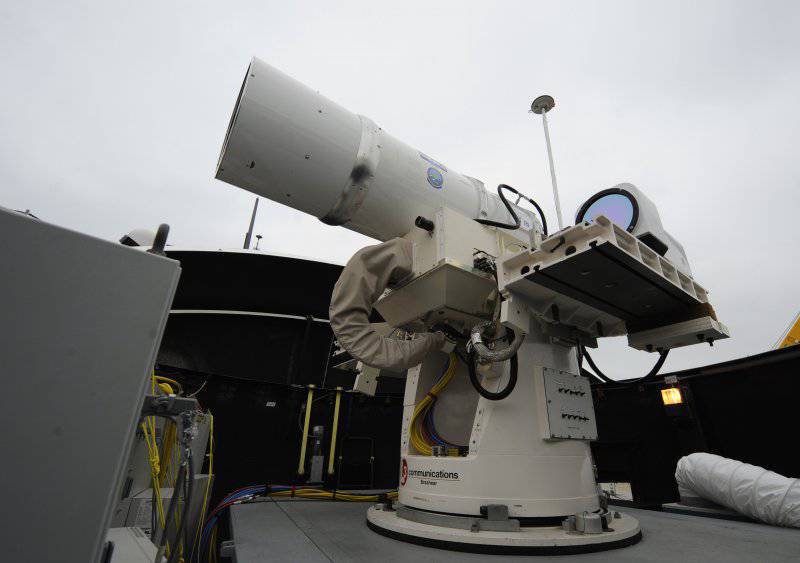
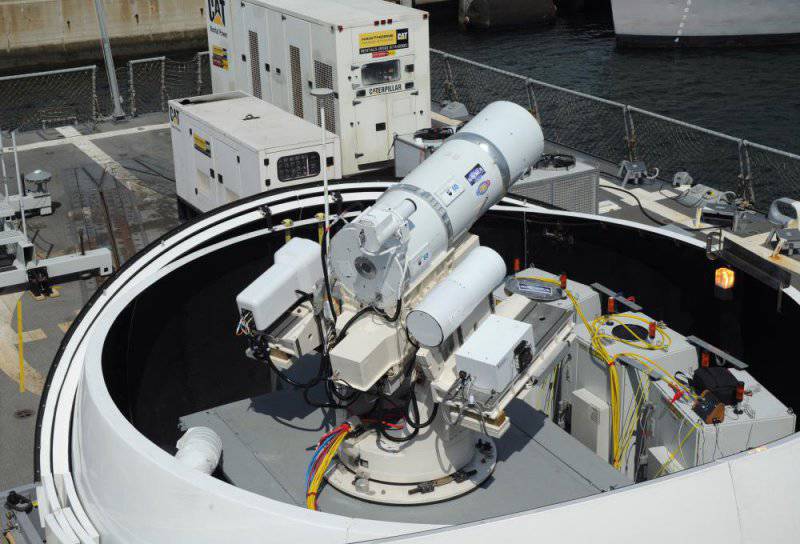
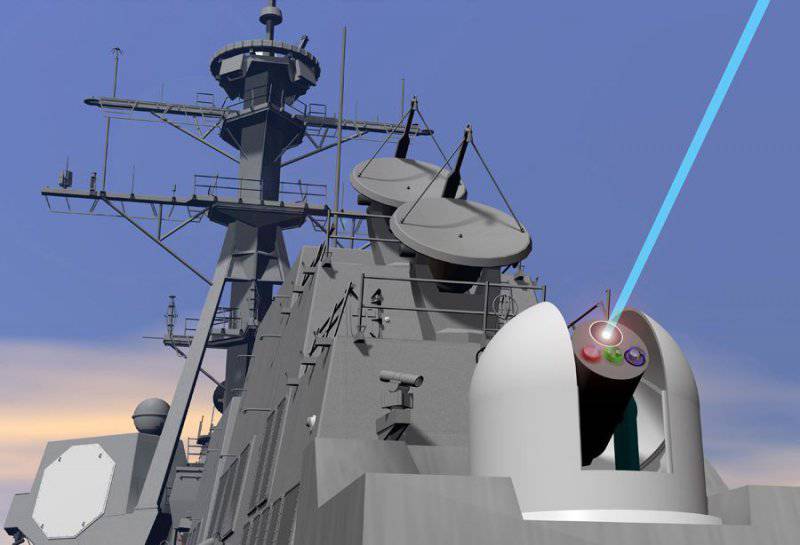
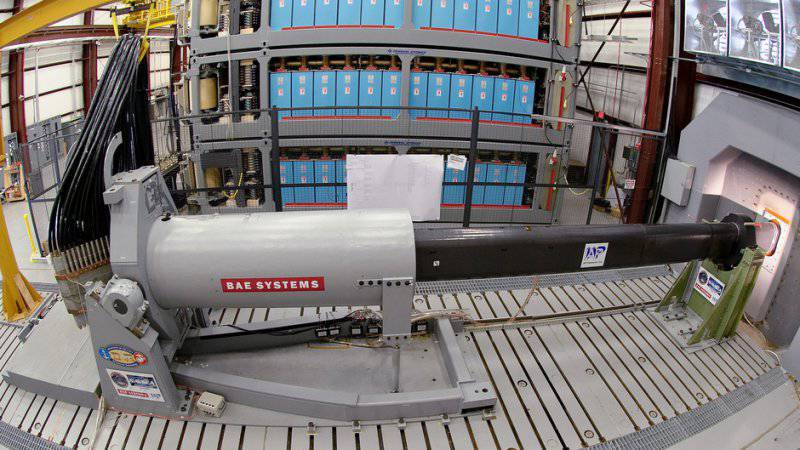
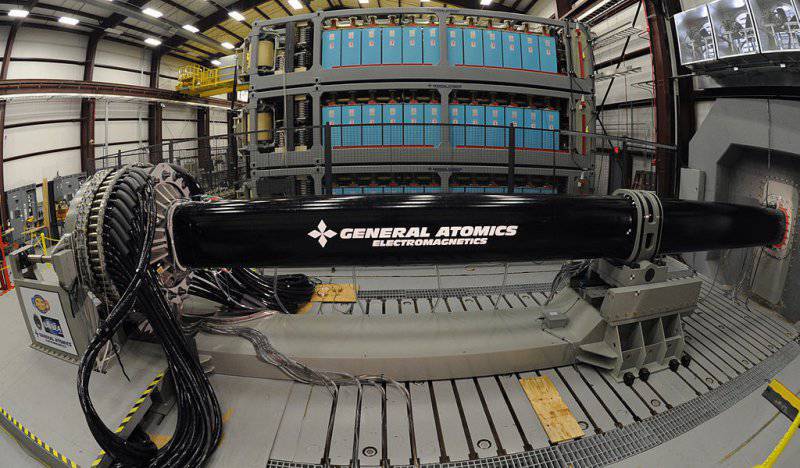
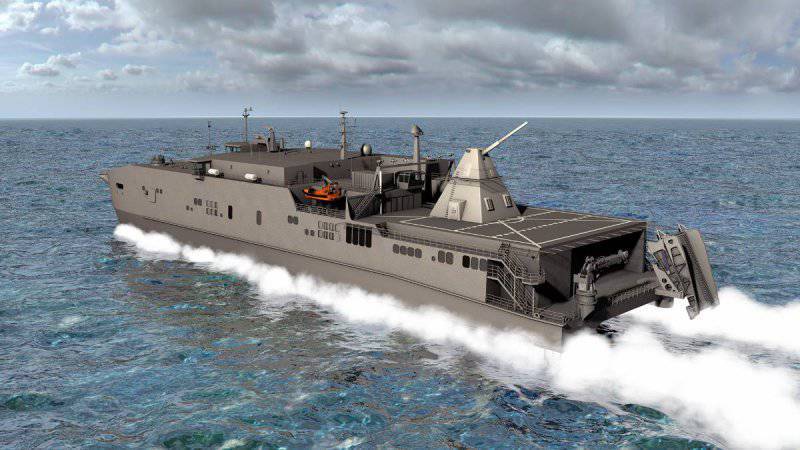
Information